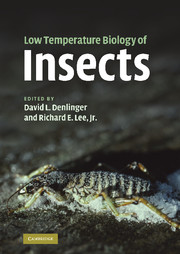Book contents
- Frontmatter
- Contents
- List of contributors
- Preface
- PART I PHYSIOLOGICAL AND MOLECULAR RESPONSES
- 1 A primer on insect cold-tolerance
- 2 Rapid cold-hardening: Ecological significance and underpinning mechanisms
- 3 Antifreeze and ice-nucleator proteins
- 4 Genomics, proteomics and metabolomics: Finding the other players in insect cold-tolerance
- 5 Cell structural modifications in insects at low temperatures
- 6 Oxygen: Stress and adaptation in cold-hardy insects
- 7 Interactions between cold, desiccation and environmental toxins
- PART II ECOLOGICAL AND EVOLUTIONARY RESPONSES
- PART III PRACTICAL APPLICATIONS
- Index
- References
4 - Genomics, proteomics and metabolomics: Finding the other players in insect cold-tolerance
from PART I - PHYSIOLOGICAL AND MOLECULAR RESPONSES
Published online by Cambridge University Press: 04 May 2010
- Frontmatter
- Contents
- List of contributors
- Preface
- PART I PHYSIOLOGICAL AND MOLECULAR RESPONSES
- 1 A primer on insect cold-tolerance
- 2 Rapid cold-hardening: Ecological significance and underpinning mechanisms
- 3 Antifreeze and ice-nucleator proteins
- 4 Genomics, proteomics and metabolomics: Finding the other players in insect cold-tolerance
- 5 Cell structural modifications in insects at low temperatures
- 6 Oxygen: Stress and adaptation in cold-hardy insects
- 7 Interactions between cold, desiccation and environmental toxins
- PART II ECOLOGICAL AND EVOLUTIONARY RESPONSES
- PART III PRACTICAL APPLICATIONS
- Index
- References
Summary
Introduction
Our understanding of the physiological mechanisms of insect cold-hardiness relies on a rich history of discovery that has revealed the presence of cryoprotective agents, antifreeze proteins, ice-nucleating proteins, heat-shock proteins and modifications of the cell membrane. Such discoveries have usually targeted select metabolites, proteins, or fatty acids, and have successfully revealed the identity of many key agents that protect insects from injury at low temperature, yet we suspect that, in many cases, additional protective agents may be involved. In some cases this may mean the potential discovery of entirely new cryoprotective agents or discovery of roles for a multitude of chemical modifications that may accompany a change in a single compound that has already been well documented. This is indeed the power of the “-omics” approach, discovery of large-scale changes at levels of the transcript (genomics or transcriptomics), protein (proteomics), or metabolites (metabolomics). These approaches are especially good for seeing the big picture. What novel genes or gene pathways are turned on or off? What proteins are uniquely synthesized or post-translationally modified in respond to the cold? What is the full range of metabolic change that occurs in response to cold, and what metabolic pathways are affected? These are the sorts of questions that can be uniquely answered by genomics, proteomics and metabolomics. Clearly, all of these approaches mark, not the end of the discovery phase, but the beginning.
- Type
- Chapter
- Information
- Low Temperature Biology of Insects , pp. 91 - 115Publisher: Cambridge University PressPrint publication year: 2010
References
- 11
- Cited by



